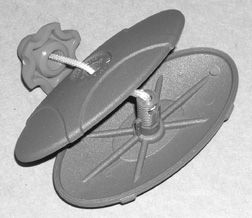
Typically, you repair torn or punctured inflatable boats with a glued patch, but the folks at Barton Marine in the U.K. have introduced a compact new device, made of hard plastic, that boasts the ability to plug any leak, so long as it’s not longer than 3.5 inches.
One half of the ClamSeal is intended to be inserted inside the leak and then drawn tight against its mate outside by way of a string that is passed through the outer clamshell, through a finger nut, and then anchored in a small plastic ball. You simply pull on the ball and string to draw the two halves tight, and then screw the nut over the bolt, clamping the two together.
We tried the ClamSeal on a child’s ball, with a material thickness of 20 ml, and it worked well. After applying the device to plug a two inch tear, we pumped the ball up to 4 psi, which is roughly equivalent to the pressure used in the chambers of inflatable boats, and left it for three days. We occasionally bounced the ball around and pushed on it now and then to test the seal. Over that span of time there were no leaks.
The ClamSeal isn’t the only device we’re aware of that is intended to perform this important service. We’ve seen two others: Fast Fix liferaft repair clamps and something called the RAM Patch. Like the ClamSeal, both of these are intended for emergencies, and thus aren’t built to do more than simply get you home. Each functions in the same way the ClamSeal does—by joining two halves under tension to seal off the puncture or tear. And all three offer the advantage of being “glueless,” which means that they can be applied underwater if necessary. But only the ClamSeal uses a bolt-and-nut method of achieving its tension, which we feel is the most secure approach. ( Because we haven’t had a chance to test the Fast Fix or the RAM Patch, we can’t readily endorse them, but it’s encouraging to know that the Fast Fix comes in three sizes, with the largest measuring 8 x 3 1/2 inches.
If you own an inflatable, the ClamSeal would be a good item to have in case of an emergency. It may not keep the leak airtight forever, but it would likely get you back to the dock or mothership. It would also be a good item to have in your ditch bag or the bag that’s kept with your liferaft.
We feel the only downside to the ClamSeal is that it is currently available in just this one size. Several larger sizes would offer assurance if your boat were to sustain a larger leak.
Contact – Barton Marine Equipment, Ltd., 800/343-8294, www.bartonmarine.com.



































